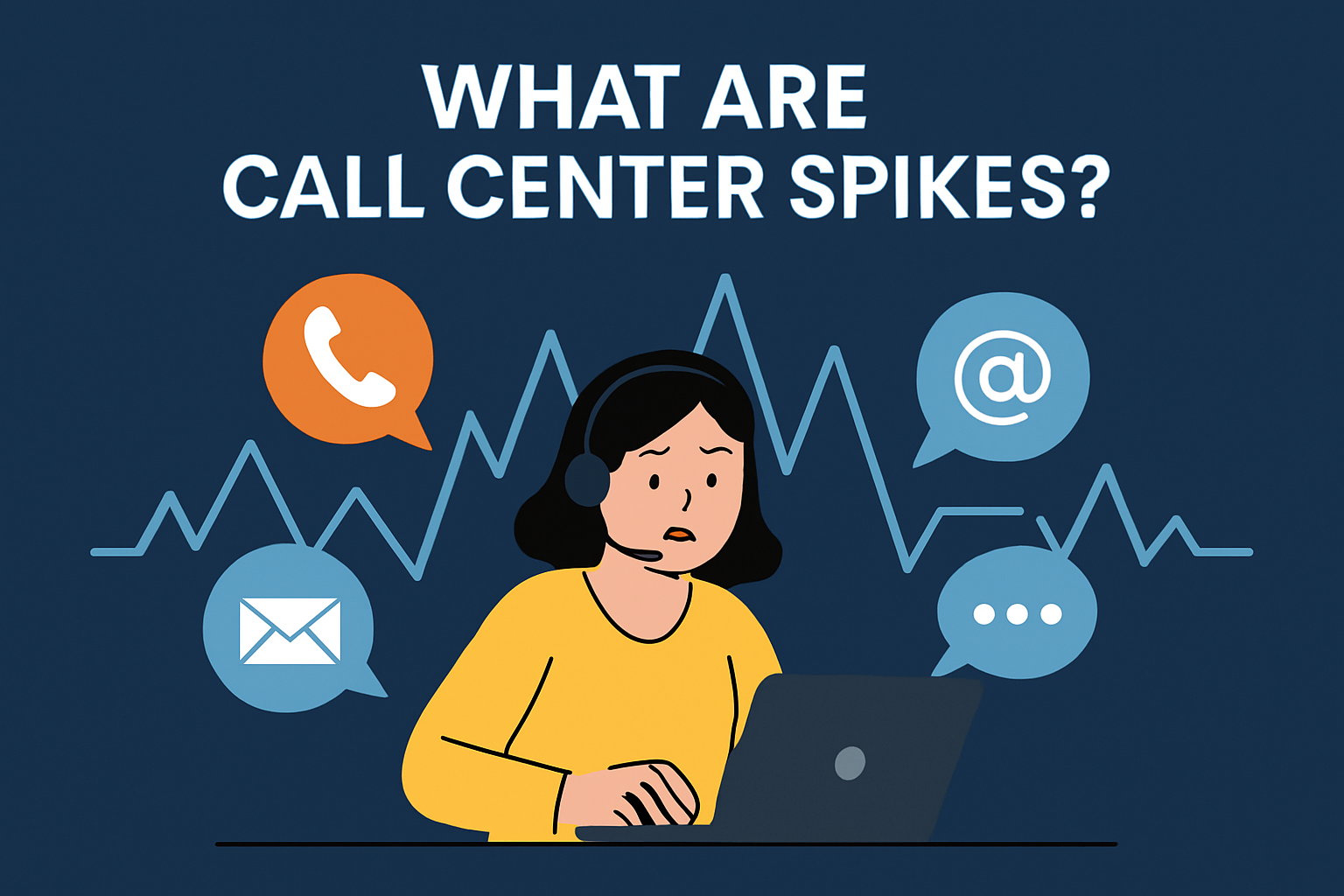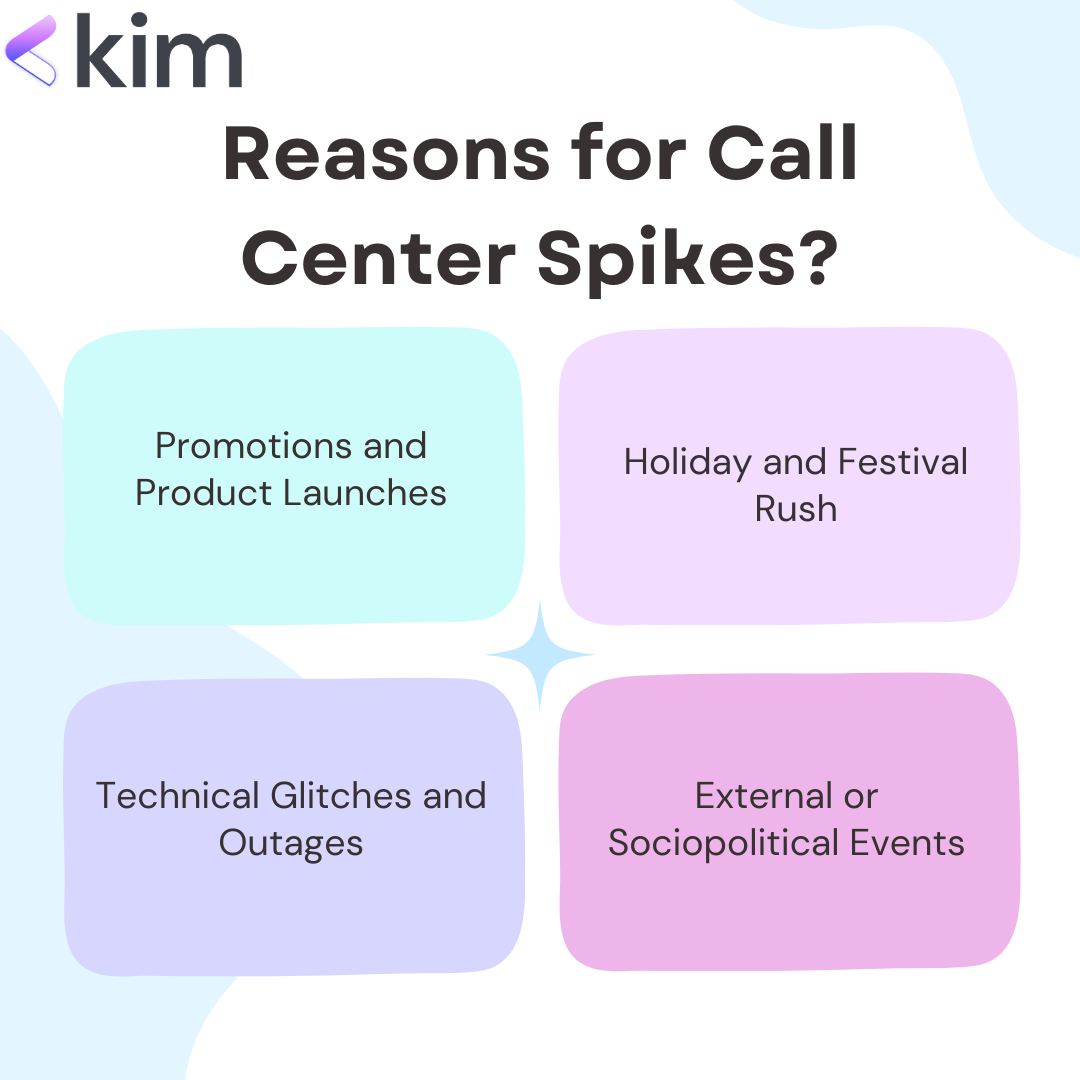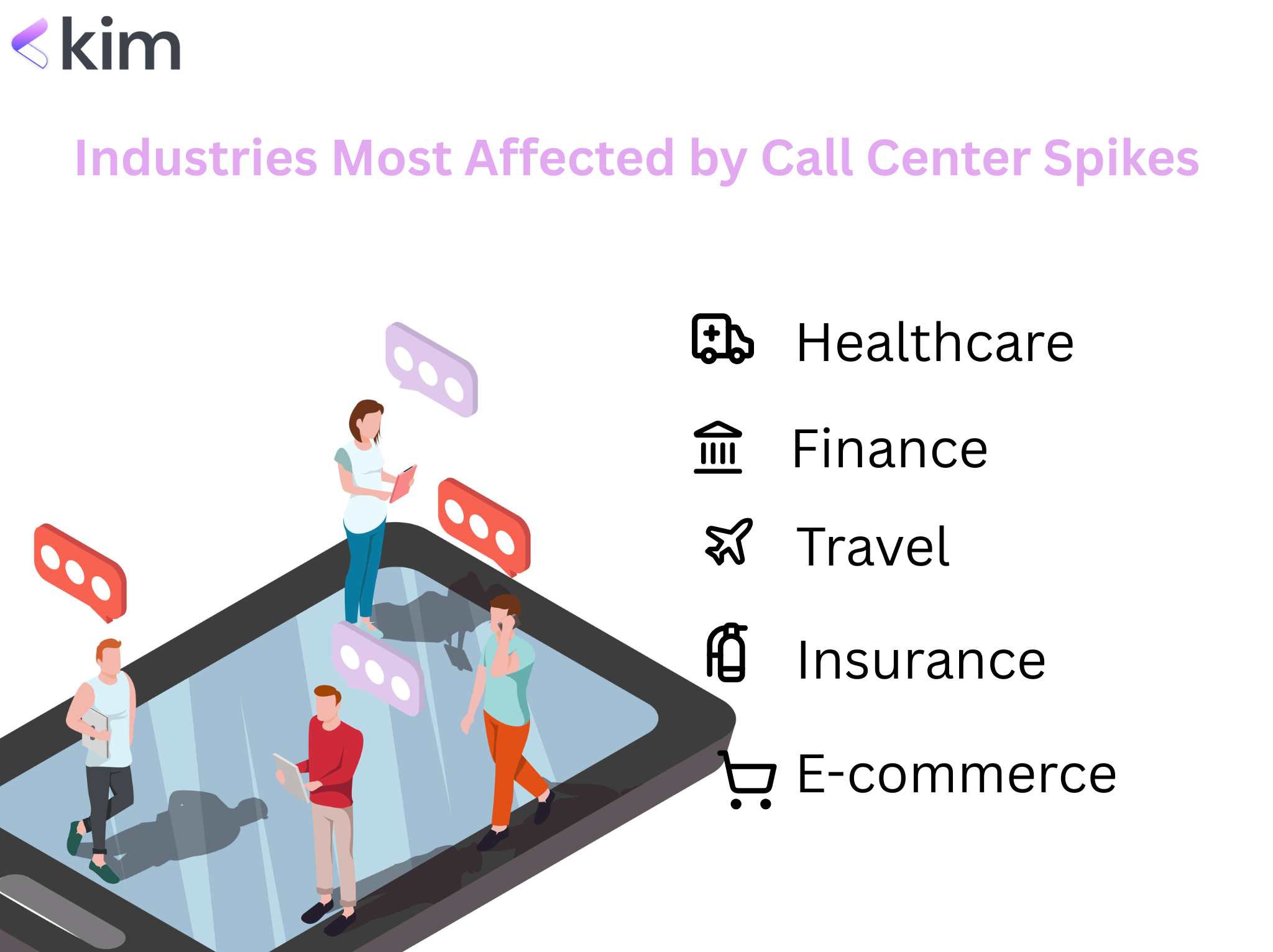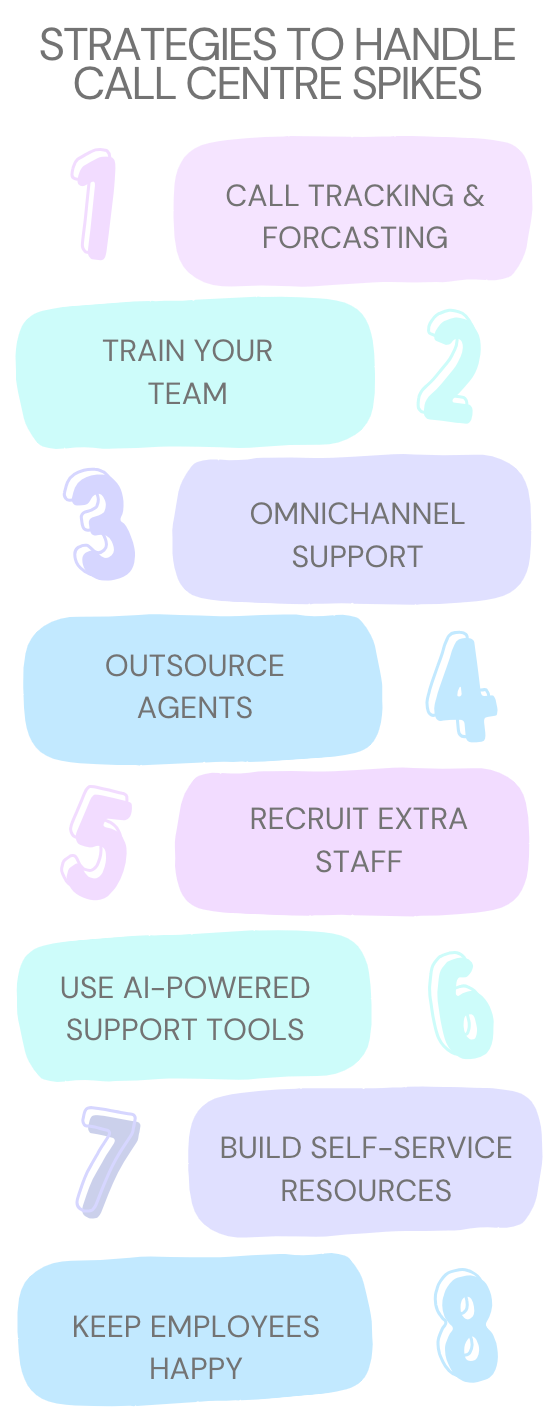How to Handle Call Center Spikes During Holidays, Promotions, and Outages
Every industry has its crunch time. For retail, it’s Black Friday. For airlines, it’s holiday travel. For accountants, it’s tax season. For call centers, it’s all of the above, and more.
These moments of sudden demand are known as call center spikes. They’re the periods when customer inquiries, calls, chats, emails, DMs, surge far beyond the daily average. One day, everything feels normal; the next, your agents are swamped with endless queues.
At first glance, call center spikes might seem like a “good problem”, after all, more customer inquiries mean more interest in your brand. But the reality isn’t so simple. Left unmanaged, spikes overwhelm teams, frustrate customers, and damage your brand’s reputation.

In this blog, we’ll explore:
- Why call center spikes happen (and the triggers behind them)
- Which industries are most affected
- What spikes mean for customer experience and business health
- Proven strategies to handle seasonal call volume surges without losing customers or burning out your team
Let’s dive in.
What Are Call Center Spikes?
A call center spike refers to any sudden surge in customer interactions, phone calls, live chats, emails, or social media messages. These spikes often happen around predictable events (like product launches or holidays) but can also arise from unexpected issues (like outages or natural disasters).
Research shows that contact centers handle 20–30% more interactions during seasonal peaks compared to off-peak months (ContactBabel). For some industries, the surge can be even higher, airlines and e-commerce companies often report 100–200% increases during peak demand periods.
The challenge? Call centers are typically staffed for “average” demand, not extraordinary demand. That means when spikes hit, your team is suddenly under immense pressure.
Why Do Call Center Spikes Happen?
Call center spikes follow patterns. If you look closely, you can often predict them before they happen. Here are the main triggers:

1. Promotions and Product Launches
When companies run big promotions or launch new products, inquiries pour in. Customers want details, clarification, and reassurance before making purchases.
- 88% of customers expect real-time support during launches and promotions (Salesforce).
- Retailers often report 20–40% higher call volumes during promotions than in normal weeks.
Think of it like opening day at a new restaurant, people line up around the block. If you don’t have enough staff, customers walk away frustrated.
2. Holiday and Festival Rush
The holiday season is the busiest time of year for many businesses, and call centers feel it first.
- Adobe reported U.S. consumers spent $9.8 billion online on Black Friday 2023. With sales surging, customer service lines saw matching spikes.
- Airlines faced record-high passenger volumes in December 2023, which translated into record-high call volumes about delays, rebookings, and cancellations.
Holidays may be joyful for customers, but for call center agents, they can be overwhelming.
3. Technical Glitches and Outages
Few things trigger call spikes faster than technical issues.
- Gartner estimates that IT outages can cause call volumes to spike 300–400% within hours.
- Even short disruptions in e-commerce checkout systems or banking apps can flood support lines.
For customers, patience is short. They don’t care if your engineers are working on it, they want answers immediately.
4. External or Sociopolitical Events
Sometimes spikes aren’t caused by the company at all. Natural disasters, strikes, new regulations, or sudden global events can cause customers to flood in with questions.
During the COVID-19 pandemic, for instance, healthcare providers and airlines experienced unprecedented spikes, with some contact centers seeing daily interactions multiply fivefold.
Industries Most Affected by Call Center Spikes
While every industry experiences spikes, some are more vulnerable.
Travel & Hospitality
Airlines, hotels, and tour operators see sharp surges around holidays, storms, or cancellations. A single snowstorm can double call volume overnight.
- In 2022, U.S. airlines logged over 1.4 million flight delays (FlightAware), leading to tens of millions of customer inquiries.
E-commerce
From Black Friday to Cyber Monday, seasonal sales drive enormous spikes.
- According to Shopify, return requests increase by 23% during January alone, directly hitting call centers after holiday shopping.
- Amazon has invested heavily in AI-driven self-service to handle spikes, reducing the need for direct calls.
Finance
Banks, brokers, and tax advisors feel spikes during tax season and market volatility. Customers want immediate clarity on refunds, transactions, or investment decisions.
Healthcare
Flu season, vaccination drives, and pandemics push patient call volume to new levels. Clinics and hospitals often struggle to answer appointment requests and test result inquiries in time.
Insurance
Natural disasters and large-scale accidents flood insurers with claims. Hurricanes, floods, and wildfires don’t just damage property, they overwhelm call centers.

Why Ignoring Call Center Spikes Hurts More Than You Think
You might think a longer hold time isn’t the end of the world. But data shows otherwise:
- 60% of customers stop doing business with a brand after one poor support experience (Microsoft).
- 95% of consumers share bad experiences with others, amplifying brand damage (Zendesk).
- Gallup found 76% of employees experience burnout sometimes, with call center agents among the hardest hit.
The risks of ignoring spikes include:
- Damaged customer loyalty. One long hold during a crisis can send customers running to competitors.
- Overflow into other channels. Missed calls don’t vanish—they appear as angry tweets, inbox floods, or negative reviews.
- Employee attrition. Burned-out agents are more likely to quit, increasing turnover costs.
In short: call center spikes aren’t just busy weeks—they can snowball into long-term brand crises.
How to Handle Call Center Spikes: Proven Strategies
The good news? With foresight and planning, call center spikes can be managed, and even turned into a positive customer experience.

Here’s a proven playbook:
1. Forecast Demand with Historical Data
Look back at previous years: Did you see a surge every January? Did Black Friday push volume up 50%? Past data is the best predictor of future spikes.
Pro Tip: Use predictive analytics tools to model call volume around promotions, holidays, or external events.
2. Add Extra Hands (Strategically)
Temporary staffing is critical. Whether it’s outsourcing to BPO partners or hiring seasonal agents, the ability to flex your workforce saves you from drowning in spikes.
- Companies that use outsourcing partners report up to 40% lower wait times during seasonal spikes.
- Virtual Assistants (VAs) provide flexibility, trained remote agents who can scale up or down based on demand.
3. Train Your Team Like a Pit Crew
Preparation prevents panic. Before a spike hits, run simulations, update scripts, and refresh FAQs.
- Call centers that invest in pre-spike training reduce average handle times by 15–20% (ICMI).
- Roleplay sessions build confidence so agents aren’t rattled during chaos.
4. Use AI-Powered Support Tools
AI reduces repetitive workload and routes inquiries faster.
- IBM reports chatbots reduce call center costs by up to 30%.
- Smart IVR systems direct calls to the right agents, while AI-powered help desks handle FAQs instantly.
For example: During holiday sales, a chatbot answering “Where’s my order?” can deflect thousands of repetitive calls.
5. Build Strong Self-Service Resources
Customers prefer solving problems on their own, if you make it easy.
- Zendesk found 69% of customers try self-service before contacting support.
- Create searchable FAQs, knowledge bases, and video tutorials.
Apple does this well, customers rarely need to call because guides are readily available.
6. Keep Agents Energized (Avoid Burnout)
Instead of vague advice like “don’t burn out your agents,” implement concrete practices:
- Use shift scheduling software to balance workloads.
- Offer recovery breaks after intense periods.
- Recognize top performers with rewards or bonuses.
A well-rested agent delivers better service, especially during high-pressure spikes.
7. Implement Omnichannel Support with Unified Systems
Customers won’t just call, they’ll tweet, DM, or email. “Being everywhere” is meaningless without organization.
Instead, use a unified inbox to track all channels in one dashboard. This ensures no message slips through the cracks and reduces duplication of effort.
8. Monitor in Real Time and Adjust
Don’t wait until postmortems. Real-time dashboards help managers spot volume surges early and adjust staffing or routing instantly.
Companies that monitor in real time report 20–25% lower abandon rates during peak periods.
Wrapping It Up: Turning Spikes Into Strength
Call center spikes are unavoidable. Whether triggered by holidays, promotions, outages, or global events, they’ll keep happening. But they don’t have to derail your operations.
By forecasting demand, staffing smartly, training your team, and leveraging AI-powered tools, you can handle spikes smoothly, and even earn customer loyalty in the process.
At the end of the day, customers remember two things: the problem they had, and how you solved it. If your call center delivers under pressure, customers won’t just forgive the chaos, they’ll trust you more.